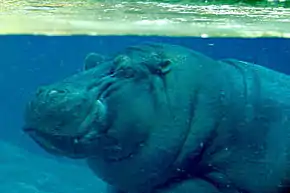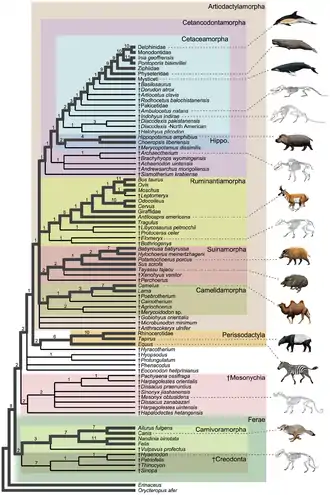Cetancodonta
Les Cétancodontes sont un sous-ordre de mammifères cétartiodactyles, regroupant les cétacés (baleines, dauphins, etc.) et leurs plus proches parents vivants, les hippopotames. Il est défini par Waddell et al. (1999)[2] comme un groupe-couronne.

| Règne | Animalia |
|---|---|
| Embranchement | Chordata |
| Sous-embr. | Vertebrata |
| Classe | Mammalia |
| Sous-classe | Theria |
| Infra-classe | Placentalia |
| Super-ordre | Laurasiatheria |
| Ordre | Cetartiodactyla |
- Whippomorpha Waddell et al., 1999 (senior)
Familles de rang inférieur
- clade Hippopotamoidea :
- clade Cetaceamorpha :
- infra-ordre Cetacea (les cétacés)
- † Dichobunidae
- † Helohyidae
- † Raoellidae
Caractéristiques

Ce clade regroupe toutes les espèces descendant de l'ancêtre commun le plus récent d'Hippopotamus amphibius et de Tursiops truncatus[3]. Le groupe élargi aux formes fossiles basales est appelé Cetancodontamorpha.
Il s'agit d'un sous-groupe des Cetartiodactyla (clade qui inclut également les porcs et les ruminants). Les analyses génétiques montrent que les cétacés ont émergé parmi des Cétartiodactyles, ce qui fait des Artiodactyles (ongulés à doigts pairs – en anglais even-toed ungulate) un groupe paraphylétique[4].
Ce terme est synonyme de Whippomorpha, mot-valise mélange d'anglais (wh[ale] + hippo[potamus]) et de grec (μορφή, morphē = forme). On a proposé de le renommer Cetancodonta[3], mais Whippomorpha — bien que le suffixe -morpha soit inadapté à la description d'un groupe-couronne — bénéficierait de l'antériorité[5].
Phylogénie
Phylogénie des familles des Cétartiodactyles actuels (Cétacés non développés), d'après Price et al., 2005[6] et Spaulding et al., 2009[7]:
| Cetartiodactyla |
| |||||||||||||||||||||||||||||||||||||||||||||||||||||||||||||||
Notes et références
- U. Arnason et al., The Mitochondrial Genome of the Sperm Whale and a New Molecular Reference for Estimating Eutherian Divergence Dates, 2000. DOI:10.1007/s002390010060
- P. J. Waddell, Okada, N. et Hasegawa, M., « Towards resolving the interordinal relationships of placental mammals », Systematic Biology, vol. 48, no 1, , p. 1–5 (PMID 12078634, DOI 10.1093/sysbio/48.1.1, JSTOR 2585262)
- Michelle Spaulding, Maureen A. O'Leary et John Gatesy, « Relationships of cetacea (Artiodactyla) among mammals: Increased taxon sampling alters interpretations of key fossils and character evolution », PLoS ONE, vol. 4, no 9, , e7062 (PMID 19774069, PMCID 2740860, DOI 10.1371/journal.pone.0007062)
- Robin M.D. Beck, Olaf R.P. Bininda-Emonds, Marcel Cardillo, Fu-Guo Liu et Andy Purvis, « A higher-level MRP supertree of placental mammals », BMC Evolutionary Biology, vol. 6, , p. 93 (PMID 17101039, PMCID 1654192, DOI 10.1186/1471-2148-6-93)
- Robert J. Asher et Kristofer M. Helgen, « Nomenclature and placental mammal phylogeny », BMC Evolutionary Biology, vol. 10, , p. 102 (PMID 20406454, PMCID 2865478, DOI 10.1186/1471-2148-10-102)
- (en) Price SA, Bininda-Emonds OR, Gittleman JL, « A complete phylogeny of the whales, dolphins and even-toed hoofed mammals (Cetartiodactyla) », Biol Rev Camb Philos Soc., vol. 80, no 3, , p. 445-473 (DOI 10.1017/S1464793105006743, lire en ligne)
- (en) M Spaulding, MA O'Leary et J Gatesy, « Relationships of Cetacea (Artiodactyla) Among Mammals: Increased Taxon Sampling Alters Interpretations of Key Fossils and Character Evolution », PLoS ONE, vol. 4, no 9, , e7062 (PMID 19774069, PMCID 2740860, DOI 10.1371/journal.pone.0007062, Bibcode 2009PLoSO...4.7062S)
- Portail des mammifères
- Portail des cétacés